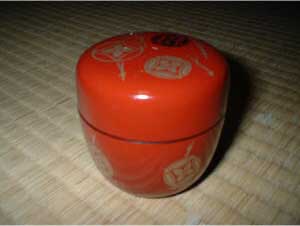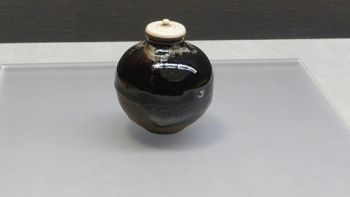Chaki
Chaki is a term present in Japanese tea culture. Word “chaki” means a tea tool. Chaki has several purposes. One of them is a caddy for the matcha (powdered) green tea used in Japanese tea ceremony. It has to be emphasised that this type of caddy is not used for storing the tea.
Chaki caddies differ according to several criteria – material, shape, potter who made them, type of tea preparation (thin tea, thick tea) where they are used etc. Thick tea or “koicha” requires almost three time more tea to the same amount of water than in thin tea or “usucha”.
There are two main type of chaki caddies – ceramic and wood or bamboo ones. Both have lids. Chaire or koicha-ki is the ceramic one which is used in preparation of thick tea.
 Usuki natsume tea caddy
Usuki natsume tea caddy
Usuki or usucha-ki is a hand-carved wooden or bamboo chaki which is used in preparation of thin tea. Most usuki caddies are shaped as “natsume” (jujube). That is why many people use word natsume to name these caddies. Usuki is usually lacquered. Many also have carved or painted designs. There are several traditional techniques. In maki-e technique artist uses a makizutsu or a kebo brush to apply different metal powders (golden, silver, copper, brass etc.) and make various textures. Nowadays plastic usuki caddies are also made.
No article about these caddies would be complete without mentioning Haneda Gorō. He lived in the Higashiyama Period of Japanese culture that was promoted in the 15th century by Shogun Ashikaga Yoshimasa. It is believed that Haneda Gorō is the one who first used this type of caddies which were then black-lacquered.
Chaire caddy is a small ceramic vessel with a lid. The lid is traditionally made of elephant ivory. It has a gold leaf on its bottom side. Nowadays quite many lids are made of materials similar to real ivory.
There are two basic types of chaire caddies - karamono and wamono (kuniyakimono). Karamono are chaire caddies from China or just made similar to the Chinese ones. Wamono are those originated from Japan. Some also mention further varieties according to shape, potter and other criteria.
 Bunrin tea caddy
Bunrin tea caddy
According to shape there are following types of karamano chaire – nasu (“eggplant”), bunrin (“apple”), bunna (“apple-eggplant”), katatsuki ("protruding shoulder"), marutsubo (“round jar”), talkal (“big jar”), tsurukubi (“crane's neck”) and shiribukura (“bulging hip”). Out of all these mentioned the most common one is katatsuki.
Wamono chaire are divided according to the names of kilns (production centres) and potters. The kilns in Seto, Aichi Prefecture and several ones in Kyoto have the status of genuine Japanese kilns involved in production of chaire. Other kilns like for example Karatsu, Satsuma or Shigaraki belong to so called kuniyakimono or provincial ware. Japanese potters famous for their chaire are Maemon, Genjūrō, Shinbei and Tōshirō.